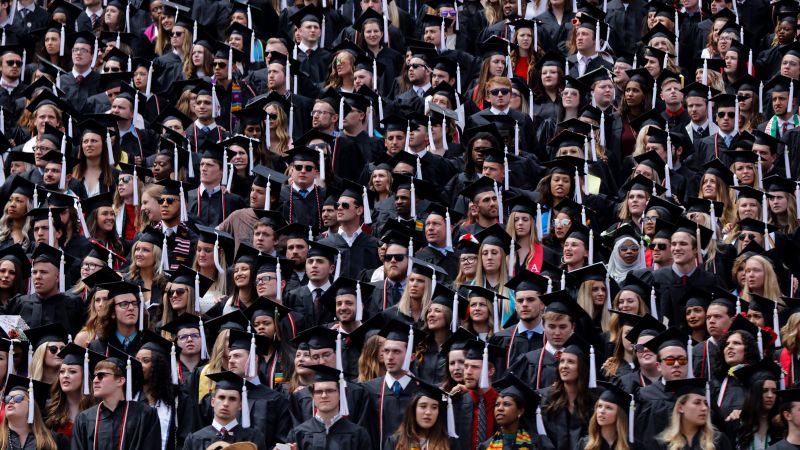
Washington
CNN
—
More than 4 million people have so far enrolled in President Joe Biden’s new repayment plan, known as SAVE, which promises to lower their monthly bills as student loan payments are set to resume in October after a yearslong pandemic-related pause.
Launched earlier this summer, the SAVE (Saving on a Valuable Education) plan is available to most people with federal student loans and can provide significant relief to borrowers struggling to pay off their student debt.
The majority of people who already enrolled in SAVE were previously enrolled in a different repayment plan, the Revised Pay As You Earn (REPAYE), and automatically transferred.
Borrowers who were not enrolled in REPAYE must apply for the SAVE plan. More than 1 million people have applied to date, the Department of Education said Tuesday.
Borrowers will be able to apply on an ongoing basis but are encouraged to apply as soon as possible if they want to be enrolled by the time they are required to make a payment in October.
On September 1, interest began accruing on federal student loans for the first time since March 2020. During that time, rates were effectively set to 0% and borrowers were not required to make monthly payments. Borrowers can expect to get a bill from their servicer at least 21 days before their payment is due sometime in October.
Biden proposed canceling up to $20,000 in student loan debt for low- and middle-income borrowers before payments restarted, but the program was struck down by the Supreme Court in late June.
Unlike the one-time cancellation proposal, the SAVE plan, can benefit both current and future borrowers. The Biden administration first said it was developing a new repayment plan last August. SAVE is expected to cost $475 billion over 10 years, according to the Penn Wharton Budget Model.
Like other income-driven repayment plans, SAVE calculates monthly payments based on a borrower’s income and family size, regardless of how much outstanding student debt is owed.
A single borrower earning $32,800 or less or a borrower with a family of four earning $67,500 or less will see their payments set at $0 if enrolled in SAVE, for example.
Borrowers are required to pay a portion of their discretionary income, which under SAVE is equal to the difference between a borrower’s adjusted gross income and 225% of the poverty level. Existing income-driven plans calculate discretionary income as the difference between income and 150% of the poverty level, resulting in higher monthly payments.
Also under SAVE, unpaid interest will not accrue if a borrower makes a full monthly payment.
That means that a borrower’s balance won’t increase even if the monthly payment doesn’t cover the monthly interest. For example: If $50 in interest accumulates each month and a borrower has a $30 payment, the remaining $20 would not be charged.
Next year, additional parts of the SAVE plan will be phased in. Those will cut payments in half for borrowers with loans from undergraduate school and shorten the time to debt forgiveness. After making at least 10 years of payments, a borrower’s remaining balance could be wiped away. Existing income-driven repayment plans usually require a borrower to pay for at least 20 years before seeing any debt cancellation.
A borrower can request to enroll in an income-driven plan online. After submitting some information, a simulator will show how much a borrower’s payments will be under each plan.
Income-driven plans can be a good option for borrowers who are struggling to afford their monthly payments. But note that if a repayment plan lowers monthly payments, it may also increase how much is paid back over time due to interest and extend how long it takes to pay the loan off. It may not be the best option for everyone.
Biden administration officials have said that it takes about four weeks for an application to be processed by a borrower’s student loan servicer after it’s submitted. If a servicer needs more time to process an application by the time a borrower’s October payment is due, they will be placed in a forbearance and won’t be required to make a payment.
After the Supreme Court struck down Biden’s separate student loan forgiveness program, the administration began pursuing another pathway to providing some student debt relief, but it’s not clear who would be eligible or how much debt would be canceled.
This pathway requires the Department of Education to undertake a formal rule-making process, which typically takes months or even years – and could still face legal challenges. That means payments will resume in October without a new student loan forgiveness program in place.
The Biden administration has already made it easier for many borrowers to seek federal student loan forgiveness from several existing debt cancellation programs – altogether approving roughly $116 billion in loan discharges for more than 3.4 million people through August.
These programs benefit people who were defrauded by their for-profit college, are permanently disabled or work in the public sector for more than 10 years while making student loan payments.

